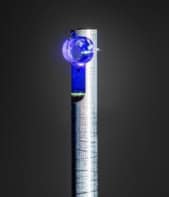Quantum chemists have discovered a new type of chemical bond in molecules that contain two uranium atoms. A total of ten electrons -- the equivalent of five covalent bonds -- are involved in the bonds. Previously the record for the largest number of covalent bonds in a molecule was four (L Gagliardi and B Roos 2005 Nature 433 848).

A covalent bond usually consists of a pair of electrons shared between two atoms. Single, double and triple covalent bonds are well known for many elements, and more complex bonds can form when large numbers of atomic orbitals are free to participate in bond formation. For instance, chemists discovered quadruple bonds between transition-metal atoms in the 1960s.
Now, using quantum chemistry computer simulations, Laura Gagliardi of the University of Palermo and Björn Roos at the Chemical Center in Lund have found that uranium, a member of the actinide group of elements, can form molecules with five covalent bonds. “This bond is unique in the all periodic table,” Gagliardi told PhysicsWeb. “Our work may have an impact on the way bonding is described in chemistry textbooks.”
Each uranium atom has a total of 16 atomic orbitals that are available for bond formation. Gagliardi and Roos used an approach called CASSCF/CASPT2 to model how all the valence orbitals in one atom merge with those in the other atom to form the most stable chemical bond — that is, the one with minimum energy.
Gagliardi and Roos found that the uranium-uranium bond is more complex than any other known diatomic bond: it contains three normal electron-pair bonds and four weaker one-electron bonds. They also find evidence for ferromagnetic coupling between two electrons, each localized on one of the atoms. This means that all the known forms of covalent bonding are found in the molecule.
The team now plans to extend its work to other diactinide molecules and to larger chemical species that contain diuranium molecules.




